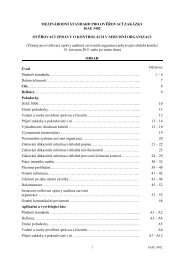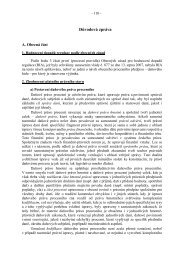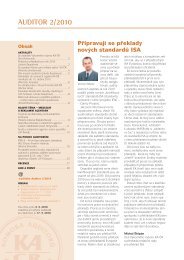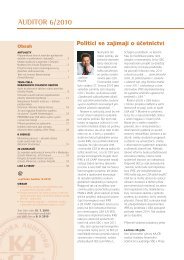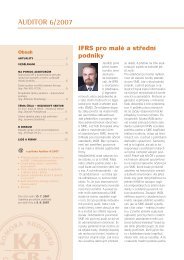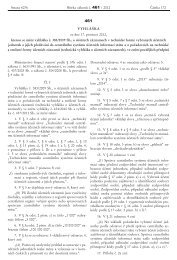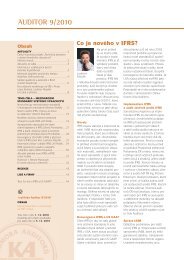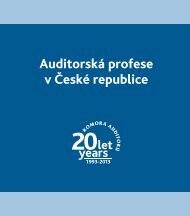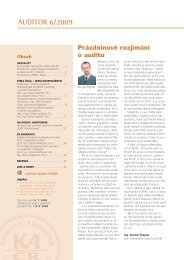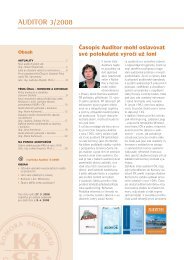Guide to Using International Standards on Auditing in - IFAC
Guide to Using International Standards on Auditing in - IFAC
Guide to Using International Standards on Auditing in - IFAC
You also want an ePaper? Increase the reach of your titles
YUMPU automatically turns print PDFs into web optimized ePapers that Google loves.
64<br />
<str<strong>on</strong>g>Guide</str<strong>on</strong>g> <str<strong>on</strong>g>to</str<strong>on</strong>g> <str<strong>on</strong>g>Us<strong>in</strong>g</str<strong>on</strong>g> <str<strong>on</strong>g>Internati<strong>on</strong>al</str<strong>on</strong>g> <str<strong>on</strong>g>Standards</str<strong>on</strong>g> <strong>on</strong> <strong>Audit<strong>in</strong>g</strong> <strong>in</strong> the Audits of Small- and Medium-Sized Entities Volume 1—Core C<strong>on</strong>cepts<br />
Communicati<strong>on</strong><br />
Communicati<strong>on</strong> is a key comp<strong>on</strong>ent of successful <strong>in</strong>formati<strong>on</strong> systems. C<strong>on</strong>sequently, if <strong>in</strong>formati<strong>on</strong> is <str<strong>on</strong>g>to</str<strong>on</strong>g> be<br />
used <strong>in</strong> decisi<strong>on</strong>-mak<strong>in</strong>g and <str<strong>on</strong>g>to</str<strong>on</strong>g> facilitate the functi<strong>on</strong><strong>in</strong>g of <strong>in</strong>ternal c<strong>on</strong>trol, it needs <str<strong>on</strong>g>to</str<strong>on</strong>g> be communicated <strong>on</strong><br />
a timely basis (both <strong>in</strong>ternally and externally) <str<strong>on</strong>g>to</str<strong>on</strong>g> the appropriate people.<br />
Effective <strong>in</strong>ternal communicati<strong>on</strong> helps the entity’s pers<strong>on</strong>nel clearly understand <strong>in</strong>ternal c<strong>on</strong>trol objectives,<br />
the bus<strong>in</strong>ess processes <strong>in</strong> use, and their <strong>in</strong>dividual roles and resp<strong>on</strong>sibilities. It also helps them understand<br />
the extent <str<strong>on</strong>g>to</str<strong>on</strong>g> which their activities relate <str<strong>on</strong>g>to</str<strong>on</strong>g> the work of others, and the means of report<strong>in</strong>g excepti<strong>on</strong>s <str<strong>on</strong>g>to</str<strong>on</strong>g> an<br />
appropriate higher level with<strong>in</strong> the entity.<br />
The means of communicati<strong>on</strong> may be <strong>in</strong>formal (verbal) or formal (i.e., documented <strong>in</strong> policy and f<strong>in</strong>ancial<br />
report<strong>in</strong>g manuals).<br />
Internal communicati<strong>on</strong> between <str<strong>on</strong>g>to</str<strong>on</strong>g>p management and employees is often easier and less formal <strong>in</strong> smaller<br />
companies, due <str<strong>on</strong>g>to</str<strong>on</strong>g> fewer levels and smaller numbers of pers<strong>on</strong>nel and the greater availability and presence of<br />
senior management.<br />
Effective external communicati<strong>on</strong> ensures that matters affect<strong>in</strong>g the achievement of f<strong>in</strong>ancial report<strong>in</strong>g<br />
objectives are communicated with relevant outside parties such as key stakeholders, f<strong>in</strong>ancial <strong>in</strong>stituti<strong>on</strong>s,<br />
regula<str<strong>on</strong>g>to</str<strong>on</strong>g>rs, and government agencies.<br />
Lack of IT Systems Documentati<strong>on</strong><br />
Smaller entities may have less sophisticated and less thoroughly documented <strong>in</strong>formati<strong>on</strong> and<br />
communicati<strong>on</strong> systems. If management does not have extensive descripti<strong>on</strong>s of account<strong>in</strong>g procedures,<br />
sophisticated account<strong>in</strong>g records, or written policies, the understand<strong>in</strong>g required by the audi<str<strong>on</strong>g>to</str<strong>on</strong>g>r will be<br />
obta<strong>in</strong>ed more by <strong>in</strong>quiry and observati<strong>on</strong> than by review of documentati<strong>on</strong>.<br />
5.6 C<strong>on</strong>trol Activities<br />
Paragraph #<br />
Relevant Extracts from ISAs<br />
315.20 The audi<str<strong>on</strong>g>to</str<strong>on</strong>g>r shall obta<strong>in</strong> an understand<strong>in</strong>g of c<strong>on</strong>trol activities relevant <str<strong>on</strong>g>to</str<strong>on</strong>g> the audit, be<strong>in</strong>g<br />
those the audi<str<strong>on</strong>g>to</str<strong>on</strong>g>r judges it necessary <str<strong>on</strong>g>to</str<strong>on</strong>g> understand <strong>in</strong> order <str<strong>on</strong>g>to</str<strong>on</strong>g> assess the risks of material<br />
misstatement at the asserti<strong>on</strong> level and design further audit procedures resp<strong>on</strong>sive <str<strong>on</strong>g>to</str<strong>on</strong>g> assessed<br />
risks. An audit does not require an understand<strong>in</strong>g of all the c<strong>on</strong>trol activities related <str<strong>on</strong>g>to</str<strong>on</strong>g> each<br />
significant class of transacti<strong>on</strong>s, account balance, and disclosure <strong>in</strong> the f<strong>in</strong>ancial statements or<br />
<str<strong>on</strong>g>to</str<strong>on</strong>g> every asserti<strong>on</strong> relevant <str<strong>on</strong>g>to</str<strong>on</strong>g> them. (Ref: Para. A88-A94)<br />
315.21 In understand<strong>in</strong>g the entity’s c<strong>on</strong>trol activities, the audi<str<strong>on</strong>g>to</str<strong>on</strong>g>r shall obta<strong>in</strong> an understand<strong>in</strong>g of<br />
how the entity has resp<strong>on</strong>ded <str<strong>on</strong>g>to</str<strong>on</strong>g> risks aris<strong>in</strong>g from IT. (Ref: Para. A95-A97)<br />
C<strong>on</strong>trol<br />
Activities




